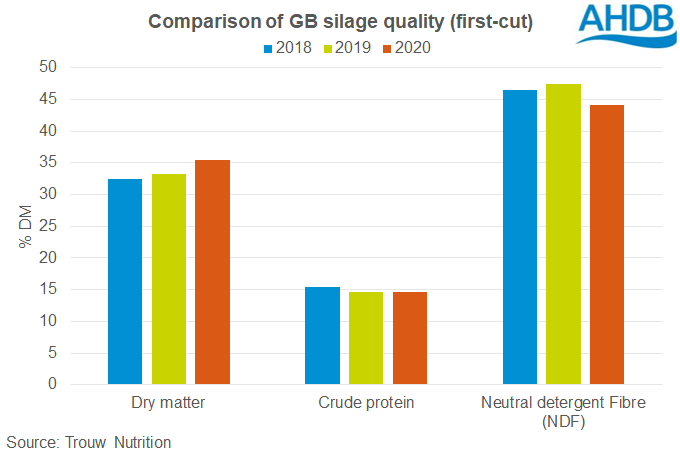Variable weather conditions reflected in grass silage quality
Thursday, 3 September 2020
By Felicity Rusk
The variable weather we have seen this year has resulted in a turbulent season for grass growth. This has had implications for both the quality and quantity of this season’s grass silage.
Early indicators of grass silage quality are positive, according to the first-cut grass silage analysis from Trouw Nutrition. However, a large variation in the quality seen between samples was reported.
Due to the mild winter temperatures, grass continued to grow throughout the winter season. As such, some samples contained a high proportion of older grass, which affected quality due to the higher lignin content.

Dry matter was higher than we have seen in the last couple of years, averaging at 35.5%. This is likely a reflection of the warmer, dry conditions experienced by most areas in the UK in April and May. The average energy content is good, although the silage has a lower fibre content that could have knock-on impacts on milk butterfat levels if not managed accordingly.
Overall, the crude protein level was lower than usual, averaging at 14.6%. The lower protein level is likely a combination of the challenges in applying fertiliser earlier on in the season, and the dry spring weather hampering plant nitrogen intake. The average level of metabolisable protein, which is available to use by the cow herself, is relatively good. However, the level of fermentable protein, which is available to the microflora in the rumen, is low. The wide range in quality of silage this year means the impact on producers will be different across the country. However, those who find themselves with a low level of fermentable protein may see feed costs increase in order to supplement it with other proteins, such as rapeseed meal, soyabean meal or distiller grains.
The average ratio of fermentable carbohydrates: protein is also on the lower end. So, similarly, farmers with lower ratios may see their feed costs increase to supplement the silage with cereals in order to provide adequate levels of fermentable carbohydrates.
While overall quality for first-cut silage looks to be good, a large variation between samples was reported. As such, it is imperative that you analyse your own grass silage, and make diet decisions based on your own silage quality.
Some areas of the country have been more affected by the variable weather conditions than others. In response, the AHDB technical team conducted a fodder stock survey in order to assess the current stock levels across the GB at the start of August.
There was 110 respondents, of which the majority were based in southwest England. Almost 70% of respondents reported some concerns about fodder in the future. Concerns included the impact of the weather on forage yield, culling livestock to manage demand and managing cash flow.
Over 50% of respondents reported that they had less fodder in stock than normal. Of which, just under half reported to have 50% less forage than normal, with the majority based in the West Midlands, southwest and southeast England. This is not surprising given that these were the areas particularly affected by the lack of rainfall.
.png)
More than 40% of respondents claimed to be short of all grass silage and a similar number reported that they were short of all forages.
Grass growth has shown some improvements since this survey was conducted. As such, discussions from our milk-forecasting forum indicated that concerns in-terms of quantity had eased, as the second-cut of grass was high yielding. However, there are ongoing concerns about the variation in quality.
Sign up to receive the latest information from AHDB.
While AHDB seeks to ensure that the information contained on this webpage is accurate at the time of publication, no warranty is given in respect of the information and data provided. You are responsible for how you use the information. To the maximum extent permitted by law, AHDB accepts no liability for loss, damage or injury howsoever caused or suffered (including that caused by negligence) directly or indirectly in relation to the information or data provided in this publication.
All intellectual property rights in the information and data on this webpage belong to or are licensed by AHDB. You are authorised to use such information for your internal business purposes only and you must not provide this information to any other third parties, including further publication of the information, or for commercial gain in any way whatsoever without the prior written permission of AHDB for each third party disclosure, publication or commercial arrangement. For more information, please see our Terms of Use and Privacy Notice or contact the Director of Corporate Affairs at info@ahdb.org.uk © Agriculture and Horticulture Development Board. All rights reserved.

